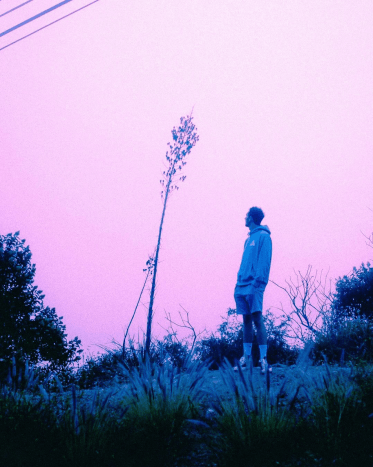Growing up in Batavia, Illinois, a Chicago suburb with a population of just over 26,000, photographer and videographer Colin Miller never imagined the adventures his camera would take him on. Now one of the many renowned artists for Louis the Child, one of electronic music’s fastest rising acts, Miller has been on stage and behind the scenes at the world’s biggest festivals and venues, traveling in the fast lane alongside the duo’s members, Robby Hauldren and Freddy Kennett, who became some of his closest friends.
Just this month, Miller added another notch to his portfolio’s already supersized belt— directing the visual companion for Candy 2, the long-anticipated 36-minute beat tape released by Louis the Child on October 2nd, 2020. Composed of sweeping landscapes, psychedelic color inversions and meticulously arranged visual scenes, the video is the longest and most involved piece of work ever made by Miller, who is also credited as an editor and cinematographer.
But even before Candy 2, Miller’s creative fingerprints have long been visible on the creative branding of Louis the Child. Along with ThankYou X and Scott Philibert, Miller has had a direct hand in shaping the colorful, nature-heavy aesthetic their fans and contemporaries have grown to know and love. Given this influence, it’s about time we all got to know him a bit more personally.
"So much of where I come from goes into what (people) see, but they only see what they see, you know? They don’t really know what’s shaped the way that it’s been shot or been made, or what’s gone into it,” Miller, now based in LA, told EDM.com. “It’s cool to share where I come from."
From humble high school origins shooting on his mom’s pocket digital camera—inspired by the videos he saw online of skateboarders and snowboarders—Miller was always enraptured by both visual media and music. He eventually realized photography was the perfect way to intersect the two, he said. While studying graphic design at the School of the Art Institute of Chicago, Miller upgraded to a Canon 6D and began pouring more time into his then-hobby. He found influence in EDM videographers like fellow Chicago native Chris Yoder, who is known for touring with The Chainsmokers, Zedd and Yellow Claw.
“He’s one of the first people I saw really out there finding a way to make consistent videos in a live music setting,” Miller said. “It was just this dude’s ability to show up somewhere with his camera and snap on something for a couple hours, and then see what he was putting together—that’s what I was fascinated with.”
After shooting his first show in 2013, Miller was making big moves of his own just two years later, touring internationally with Jai Wolf and working on videos for NGHTMRE. Louis the Child's management first reached out to him in 2016, and Miller ended up filming for the duo at Lincoln Hall in Chicago that spring. From there, their relationship is history.
“I honestly don’t think it stopped,” Miller said of his working relationship with Louis the Child. “It went from there to another show, another show, another show.”
Since then, Miller and the duo embarked on their creative journeys together. A natural friendship, which was spurred along by similar upbringings in the Chicago suburbs, helped foster a deeper level of earned trust when it came to their joint endeavors. The rapport ultimately allowed Miller to take the lead on the execution of Kennett’s and Hauldren’s ideas, paving the way for collective growth and experimentation.
Translating music into visuals is not all roses, though. It involves a sophisticated understanding of the artist and their work; especially of how they want their music to be represented and received by fans. Miller defined the phenomenon as “connecting the dots” between an artist’s initial vision and an execution that will resonate with viewers.
“It really just starts with getting to know the artist for everything from who they are, to why they’re doing what they’re doing, to the impact they want to have on people,” Miller explained. “Going back to Louis the Child…I can see the meaning of it all, and I think that comes out in the stuff I make for them.”






Today, the aesthetic Miller has helped craft for Louis the Child revolves around giving people something that will make them happy, he said. It includes being “as colorful as possible,” incorporating pleasant, pretty imagery like nature and flowers, he added. Elements of Miller’s personal art are interwoven with this guiding theme, with bright, contrasting hues or splices of different film and photo formats adding an “otherworldly” touch to compliment their music. An ever-evolving look, Miller is constantly keeping a careful, absorbent eye on the “artistic energy” the two put out, he said.
Beyond the visual feel of their brand, what’s most important to Miller is that his work is emotionally honest, which Hauldren and Kennett make easy with their commitment to keeping it real. Authenticity is at the center of Miller's creative drive, and he searches for it in visible displays of emotion, special moments and organic experiences. Fundamentally, he’s opening up a "window” into artists as people—not just icons—he explained. “I like making people feel something, and I really feel like the best way to do that is just delivering something that’s real,” Miller asserted.
Crafting the visuals for Candy 2 this summer perfectly reflected this central tenet of authenticity. Inspired by the concept of Kennett’s dreams, the video’s content was shot by Kennett, Hauldren and Miller throughout a four-day road trip in the American Southwest's August heat. Their hefty location list included Zion National Park, Valley of Fire State Park and Horseshoe Bend. But beyond a shoot schedule and shot list, Candy 2 simply involved some dudes hanging out in the desert, making it a far cry from the heavily staffed and regimented productions common to the music industry.
“We wanted to heavily focus it on nature, and the earth, and the natural beauty of things,” Miller recalled. “That was our biggest game plan. From there it was just a bunch of friends making cool stuff, looking to shoot cool stuff, looking to see cool stuff.”
The final edit, of which Philibert served as a main editor, brought the video home with flashing color inversions, jump cuts and lens distortions. The video also incorporated drone footage from fellow cinematographers Dan Franco and Max Depatie, who shot in Northern California and Oregon. The resulting visual companion looks just as fun as it undoubtedly was to make.
That idea is core to who Miller is, too, whose life is the ideal synthesis of work and play. He never intended to turn photography and videography into a career, he said, and was just following the fun and the passion until it led him somewhere new. And now that he is on this road, he’s still in touch with the same instincts that led him out of Batavia, developing his interests and staying true to himself.
“You know, I feel like none of this has changed me as a person. And I think that’s why a lot of this has seen the success that it has. This has always been me, and I’ve just always enjoyed doing this,” Miller reflected. “I think good things are going to follow that.”
FOLLOW COLIN MILLER:
Twitter: twitter.com/itscolinmiller
Instagram: instagram.com/itscolinmiller



